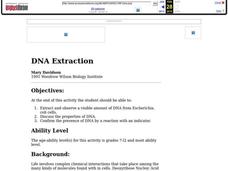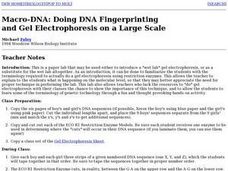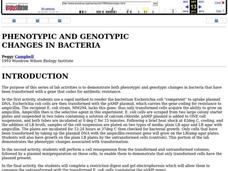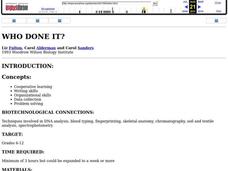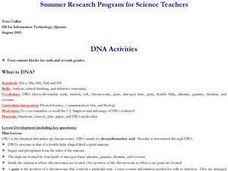Curated OER
DNA Extraction
Students are able to extract and observe a visible amount of DNA from Escherichia coli cells. They discuss the properties of DNA. Students confirm the presence of DNA by a reaction with an indicator.
Curated OER
Macro-DNA: Doing DNA Fingerprinting and Gel Electrophoresis
Students create numbered DNA sequences by taping together the order of the sequence. They count the number of bases in their RFLP's and shade the boxes on their Gel Electrophoresis sheets that represent individual fragments. They...
Curated OER
Fingerprinting
Students discover the basics of fingerprinting and how it identifies a person. They create their own fingerprints and compare them to classmate's to determine that no two people have the same identity because of fingerprints. Then they...
Curated OER
The Structure of DNA
Students will demonstrate knowledge of the structure of DNA by constructing simple models of DNA with materials given to them in class. They will also discover that some female scientists such as Rosalind Franklin have not been given...
Curated OER
Gene Regulation Mechanisms
Young scholars explore genetics. They discuss how chromosomes and/or genes are regulated during the life of an organism. In a lab setting, students compare and contrast the genomic regulation of prokaryotic and eukaryotic cells using...
Curated OER
Simulation of Gene Splicing
Students simulate gene splicing by examining bacteria. They create a bacterial DNA into which they insert the human DNA (gene) that codes for growth hormone. They cut the sites of the enzyme to study how the human DNA can be joined to...
Curated OER
Wolves: DNA Pawprinting
Students explore and research the most widely distributed terrestrial carnivore, the wolf. They critique the true mystery of this animal and then form an opinion about this creature. The restriction-site analysis of mitochondrial DNA is...
Curated OER
Phenotypic and Genotypic Changes in Bacteria
Students investigate a rapid method to render the bacterium Escherichia coli "competent" to uptake plasmid DNA. They demonstrate the phenotypic changes associated with transformation. They perform a cell resuspension from the...
Curated OER
Who Done It?
Students work in groups to solve various murder mysteries using DNA evidence to implicate suspects. Teams compete to solve the crimes the fastest, while using various scientific methods to accomplish their task.
Curated OER
Gene Action and Mutation
Students review terms related to DNA structure and function. They complete a variety of worksheets in small groups or in pairs reflecting the unit's concepts regarding DNA. They submit their worksheets for grading.
Curated OER
DNA Sequencing Simulation
Young scholars simulate the Sanger method of DNA sequencing using color pop-beads as a representation of nucleotides and dideoxynucleotides. Students assemble DNA sequences and run their sequences through a "sequencing gel" and sketch...
Curated OER
Where's the CAT? a DNA Profiling Simulation.
Students explore DNA technology. Students participate in a simulation to perform at the basic steps of a DNA profile. They observe copies of DNA sequences, construct DNA probes, and discuss outcomes of their experiment.
Curated OER
DNA Fingerprinting: You Be the Judge!
Students explore DNA fingerprinting. Students discover how DNA fingerprinting is done and judge the validity. They evaluate the use of certain prints in courts and address the ethics of establishing a national database of fingerprpints.
Curated OER
Electrophoretic Analysis: DNA Fingerprinting and Evolutionary Divergence
Young scholars examine the principles of electrophoresis. They evaluate both the agarose and polyacrylamide system of molecular separation. In order to bring the concepts of genetics and evolution full circle from DNA to protein,...
Curated OER
Genome's Greatest Hits
Students explore the progression of discoveries that have led to the genetics knowledge that scientists currently have. In groups, students research scientists that have made important contributions to understanding the molecules behind...
Curated OER
DNA and Individual Differences
Students list differences between DNA-related terms and create a simple DNA circle map. They order terms including human body, organ, tissue, cell, nucleus, etc. from largest to smallest. They discuss differences and similarities among...
Curated OER
DNA Week
Learners perform different activities about DNA for a week in order to celebrate DNA Week and raise their awareness of DNA. The teacher is provided with a different theme for each day.
Curated OER
Building YOU from MOO
Students build protiens according to whether they are suppose to be a plant, a cow, or a person. They discover that all proteins are made from the same amino acids and it is just the order of these amino acids that change.
Curated OER
Molecular Medicine Comes of Age
Young scholars simulate the roles of employees of two fictional pharmaceutical companies to analyze how human genetic variation at a molecular level helps scientist better understand and treat disease. They explain the molecular...
Curated OER
Using VNTR Analysis to Identify Guilt at a Crime Scene
Students collect DNA from cheek cells. They compare and contrast the processes of DNA replication and PCR. They discuss how this information can be used to determine guilt at crime scenes.
Curated OER
DNA Activities
Students work together to identify the structure of DNA. They practice using new vocabulary as well. They create a 3-D model of DNA to complete the lesson.
Curated OER
Anticodons And Amino Acids Game
Students examine the process of protein synthesis. In small groups, they select an index card, and translate the DNA to an amino acid, and define the words on an anticodon/amino acid chart.
Curated OER
"Who Done It?" Analysis of Molecular Fingerprints Left At the Scene of the Crime
Students examine different types of DNA fragments. They record and analyze their results. They determine who is the criminal in the story.
Curated OER
Lost Tribes of Israel
Students examine the issues involved with using DNA evidence in a courtroom trial. They read and discuss a case study of a particular trial, conduct research, and role-play a jury by reporting their verdict and discussing how they...


